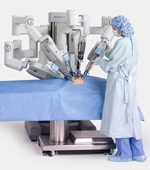Robotic Surgery
SMART surgery (Samadi Modified Advanced Robotic Technique) is an innovative technique, it is a robot-assisted laparoscopic prostatectomy (the RLP), developed by Dr. Samadi, which reduces surgical time to less than two hours and recovery from hospital stay to less than 24 hours.
More security
Fast recovery
Lower Risks

Dr. Samadi performs robotic prostate cancer surgery using the da Vinci robotic system.
This minimally invasive procedure uses the latest advances in robotics and computer technology to remove the cancerous prostate.
The surgeon's console houses the master controls used by Dr. Samadi to manipulate the patient-side cart and the EndoWrist instruments. Dr. Samadi's expert hands, translated to the EndoWrists, control all movements of the robot. It remains the surgeon who is in control of the robot at all times throughout the procedure.
During the procedure Dr. Samadi has a 3D view of the surgical field through the Insite vision system. This is a vast improvement over traditional surgery and the 2D view of laparoscopic surgery. High definition video cameras give 10X to 15X magnification for greater depth perception and a clearer field of view. It allows for enhanced visualization of the prostate capsule while taking care of the neurovascular bundles responsible for erectile function and reconnecting the urethra to the bladder.
The robotic surgery capabilities provided by the da Vinci System offer several advantages over the traditional laparoscopic method of surgery for treating prostate cancer compared objectively in the following areas:

Clinically superior results

Reducing the risk of complications
Surgery is always a medical procedure with inherent risk. However, for cancer treatment, surgical options may be the most effective option in eradicating malignant tumors without painful side effects of chemotherapy and radiation therapy. Among the most serious risks associated with surgical treatment is the possibility of infection at the incision site(s).
These infections are often the leading causes of serious complications that can hinder your ability to recover quickly and properly from your procedure. The da Vinci System greatly mitigates the risk of infection in a number of ways. First, the size of the incision(s) is actually significantly smaller with robotic surgery than with the traditional procedure.
A non-robotic prostatectomy typically requires the surgeon to make a six- to eight-inch vertical incision in the patient's lower abdomen. A relatively large incision exposes the patient to a number of operative and infectious agents postoperatively. This means that not only is the open incision site susceptible to any infectious agents during the procedure, but also the unhealed wound closure that results from the incision may be at risk for harmful infections.
Postoperative infections are the most common of the two categories of infection risk, as are hospital rooms that cannot be maintained at the extremely high level of sterility that robotic-only operating rooms can provide. The da Vinci Robotic Surgical System, however, uses a much less invasive technique that requires four to five smaller incisions of two inches each. Each of these smaller incisions heals much faster than the six- to eight-inch incision required in traditional surgery. Fewer sutures are needed to close the robotic system's incisions. This speeds up recovery time, as well as being less painful for you as the patient.

Minimize scars
When your doctor determines that surgery is the best treatment option and refers you to an oncologic surgeon, you can be assured that Dr. Samadi and the da Vinci System offer you the best chance for a complete and convenient recovery. Da Vinci surgical robotic technology optimizes the chances for a faster recovery versus traditional surgical prostatectomy. The smaller incisions required to manipulate the operating arms heal much faster, require fewer stitches, and are less vulnerable to breakage or infection. The high-precision movements of the robotic arms allow for cleaner removal of malignant tissue. Such precision also translates into a more targeted approach that reduces damage to healthy tissue during the operation. The design of the robotic operating arms allows the entire procedure to be performed without the need for operating tools against the incision walls. All of these advantages translate into a faster and less worrisome recovery period.

Faster recovery period
The size of the incision required to perform a traditional prostatectomy results in significant scarring of the patient's lower abdomen. The robotic prostatectomy procedure allows for incisions that can heal with little to no visible scarring. In addition to the obvious cosmetic value, minimizing scarring on the interior walls of the incision can promote better healing of the prostate. Excess scar tissue that builds up can sometimes interfere with proper prostate function. Although this complication is typically considered rare, it is worth considering exploring treatment options. The precision of robotic surgery offers an inherent solution to this potential difficulty. By minimizing the overall size of the incision needed to remove cancerous tissue this risk of scar tissue related complications is greatly mitigated.

Surgeon's Console

Patient car side
